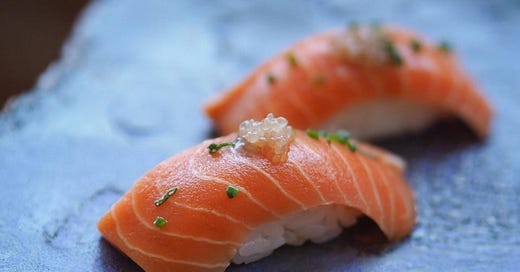Happy New Year! For the 100th issue of Design Lobster we’re going back to our proverbial roots and considering design with an aquatic theme. We’ll be looking at a company that has found a way to grow fish so we don’t have to catch them, and some positively crustacean cutlery 🦞🍴
I’d also like to share that for the first few months of 2022 I’ll be trying out a slightly different schedule. You can expect your regular edition every other Monday, which will give me a bit more time to work on some longer-form pieces for you. Stay tuned!
✨I’m so grateful that 1,246 of you find space in your lives and your inbox for this newsletter. I’d love to hear your ideas for how we can take Design Lobster to the next level in 2022.
I’ve put together a very short survey at the link below. If you have 2 minutes, please let me know what you think!
Question: How might we grow fish, rather than catching them?
My curiosity was piqued recently by a San Francisco based company called Wildtype, who are trying to commercialise so-called cellular agriculture. Their factory process begins with a few cells from a wild salmon, which are then grown in tanks on plant-based scaffolds using a special feedstock that mimics the range of nutrients that the fish absorbs in the wild. It all sounds very high-tech (and perhaps to some reading this, faintly disconcerting!) but their website insists the technology is not that dissimilar from what is found in a microbrewery.
Wildtype’s ambition is to provide a healthier and more sustainable alternative to wild-caught and farmed salmon. Challenges to reaching that goal remain, including the cost of the process and the meat’s tendency to fall apart when cooked. Nevertheless, by all accounts they seem to have nailed the taste side of things.
More intriguing still is the future the company envisions for meat production. They claim the technology will become completely ubiquitous, with families growing their own meats at home just like a kombucha brew or sourdough.
Design takeaway: How could you grow more of your design?
🐟 Watch a news report on Wildtype’s salmon.
Object: Lobster pick
Well, it just wouldn’t be Design Lobster without some niche historical cutlery now and again, would it! Today, I’d like to introduce you to the venerable lobster pick (or fork). A staple at the upper middle-class Victorian dining table, this variation on a regular fork has elongated and splayed tines to permit its users to excavate delicate lobster flesh from the deep recesses of the shell. 19th century etiquette insisted diners must not touch food to convey it to their mouths which presented particular challenges for the variety of sea creatures being presented on dinner plates. Besides the lobster fork, the respectable diner settling down to their fish course would need to identify and operate fish knives, oyster spoons and terrapin forks 😳 each one slightly adapted to the animal in question.
I’m especially interested in the social history that designs like this inadvertently document. The profusion of cutlery on European and American tables is the material evidence of the rapidly emerging Victorian bourgeoisie and its rigid codes of behaviour. Cutlery like a lobster fork helped catch out and exclude those without the right upbringing or experience, quietly reinforcing social structures with every faux-pas.
Design takeaway: What social codes does your design implicitly reinforce?
🦞 Read David Foster Wallaces incredible 2004 essay on the social history of lobster consumption (from which I nakedly stole this week’s title)
Quote: “I’ve had very few “lightbulb” moments in my career when I suddenly realized the solution to a hard problem. For me, waves lapping the beach is a much better analogy. I wear down problems with persistent and repeated effort.”
– Ken Kocienda, author of Creative Selection
I’ve featured Ken’s ideas a few times over the years. This quote, with its fittingly marine metaphor, came from a tweet he shared last year. I immediately identified with the sentiment and thought it might set us off nicely as we pick up our tools again for 2022.
Keep wearing down those problems this week,
Ben 🦞
Enjoyed this week’s Design Lobster? Let me know by clicking the heart button ❤️
👇






Congrats on #100! Design Lobster is one of those neat little finds I now anticipate dropping into my inbox.
Happy 100th post Ben!!!